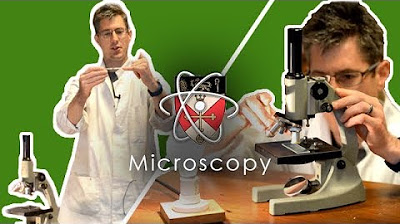Practical 2.1 Observation with a light microscope
Summary
TLDRThis instructional video explains the essential steps for using a light microscope in biological studies. It details the components of a compound microscope and provides a step-by-step guide on how to set it up and focus on a specimen. Starting from placing the microscope on a bench to adjusting the light source and using different objectives, the video emphasizes careful adjustments for clear imaging. Viewers learn how to select and observe specimens in detail, making the process accessible for beginners in microscopy.
Takeaways
- 🔍 The light microscope is a crucial tool for biological studies, utilizing light and lenses to magnify specimens.
- 🔭 The microscopes used in laboratories are typically compound microscopes, which have multiple components for effective viewing.
- 🛠️ Key parts of a compound microscope include the eyepiece, body tube, coarse adjustment knob, fine adjustment knob, nose piece, objectives, stage, clips, condenser, diaphragm, and light source.
- 📏 To begin using the microscope, place it on a stable surface and insert a low power eyepiece into the body tube.
- 💡 After turning on the light source, adjust the diaphragm for optimal lighting before placing a prepared slide on the stage.
- 🔄 When adjusting the stage, always observe from the side to prevent damaging the slide or objectives.
- 🎯 Focus on the specimen by raising and lowering the stage using the coarse and fine adjustment knobs.
- 🔍 Once the specimen is in focus at low power, search the field by moving the slide to observe different parts in detail.
- 🔬 Switch to a high power objective for a closer look, ensuring the specimen remains in focus before fine-tuning the clarity.
- ⚠️ Avoid using the coarse adjustment knob when focusing at high power to prevent potential damage to the slide.
Q & A
What is the primary function of a light microscope?
-The primary function of a light microscope is to produce magnified images of specimens using light and a set of lenses.
What components make up a compound microscope?
-A compound microscope consists of an eyepiece, body tube, coarse adjustment knob, fine adjustment knob, nosepiece, objectives, stage, clips, condenser, diaphragm, and light source.
What is the first step in preparing to use a light microscope?
-The first step is to place the microscope on a stable bench.
How do you adjust the light when using the microscope?
-You turn on the light source and adjust the diaphragm until the light is sufficient for viewing the specimen.
What should you do after placing a slide on the stage?
-You should ensure that the specimen is directly over the hole of the stage and then begin to adjust the focus.
What is the correct procedure for focusing on a specimen at low power?
-You should raise the stage using the coarse adjustment knob until it is close to the slide, look through the eyepiece, and slowly lower the stage until the image is roughly in focus, then use the fine adjustment knob for a sharp focus.
What should you do after achieving focus at low power?
-You should search the field by moving the slide to find a part of the specimen to observe in detail, centering that part in your view.
How do you switch to high power magnification?
-You rotate the nosepiece to select a high power objective while ensuring to watch the stage from the side to prevent the objective from touching the slide.
What should you avoid when focusing with a high power objective?
-You should avoid using the coarse adjustment knob when focusing with a high power objective to prevent damaging the slide or the objective.
What do you do if you cannot get a clear image while using high power?
-If you cannot get a clear image, you should watch the stage from the side and turn the coarse adjustment knob to raise the stage until the objective nearly touches the slide, then fine-tune the focus with the fine adjustment knob.
Outlines

此内容仅限付费用户访问。 请升级后访问。
立即升级Mindmap

此内容仅限付费用户访问。 请升级后访问。
立即升级Keywords

此内容仅限付费用户访问。 请升级后访问。
立即升级Highlights

此内容仅限付费用户访问。 请升级后访问。
立即升级Transcripts

此内容仅限付费用户访问。 请升级后访问。
立即升级浏览更多相关视频

CSL FK - CSL 1 Pengenalan Mikroskop

How to Use a Microscope

How to use a Compound Microscope| Monocular brightfield microscope

Tipos de microscópios, conheça na prática

Definisi dan Fungsi Mikroskop | Lomba Media Pembelajaran SIT Nurul Fikri

Microscopy - How to use a microscope - GCSE Science Required Practical
5.0 / 5 (0 votes)
